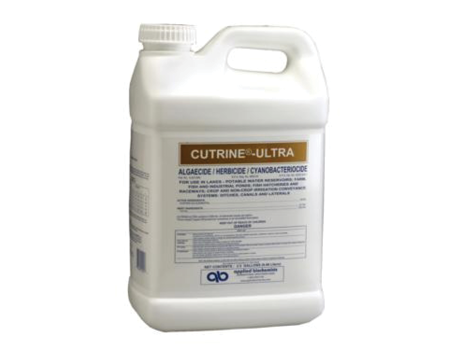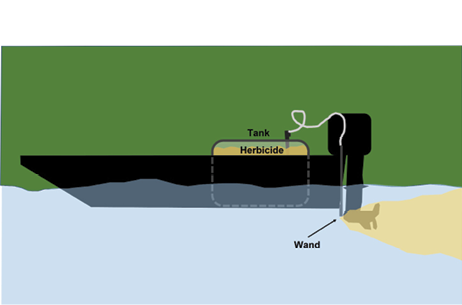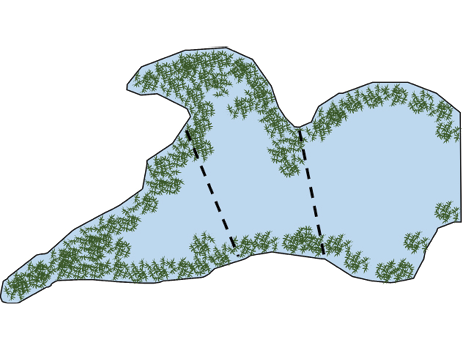Herbicide Application for Aquatic Plants

Some herbicides already have surfactants included,
so make sure that they are aquatic-approved and nonionic.

mix the chemical in the water column.
For application in deeper areas, weighted hoses can be used.

when plants are dense.
Steps to Treat Aquatic Plants
- Accurately identify the plant.
- Determine the extent of infestation.
- Select an approved aquatic herbicide.
- Determine the quantity of herbicide to purchase per treatment area.
- Mix herbicide solution to apply to plant surfaces or put in the water.
- Treat the area multiple times, if necessary.
Identifying the Plant
Herbicides are often specifically developed to treat certain plant species and are much less effective on other plants. MSU Extension provides resources to help identify aquatic plant species, and Extension professionals or other biologists can help with selecting the most appropriate and cost-effective treatment.
Herbicide Types
Herbicides can be classified by how they kill the plant. Contact herbicides are fast-acting and kill the plant at the contact location, but do not move around inside the plant. With contact herbicides, it is important to fully wet as much of the plant as possible, as only the drenched area will be affected.
Contact herbicides kill quickly, so care must be taken to avoid eliminating too much of the plant to avoid loss of oxygen from the water body.
When plants are abundant, it is best to treat about one-third of the infestation at a time. Another treatment should be applied after the previously treated material decays, with about 2 weeks between applications. Supplemental aeration can prevent oxygen issues.
Contact herbicides include copper and copper complexes, carfentrazone-ethyl, diquat, endothall, and flumioxazin. Algaecides include these products as well as peroxide compounds.
Systemic herbicides are taken in by the plant and translocated by the vascular tissue to their site of action within the plant. This can effectively kill the entire plant, including the roots, even when the plant is not fully wetted. This process takes longer than contact herbicides, sometimes a month or more. Slow death means a lesser risk of oxygen depletion, and with many systemic herbicides, the whole pond can be treated in a single application.
Systemic herbicides include 2,4-D, glyphosate, fluridone, triclopyr, imazapyr, imazamox, penoxsulam, bispyribac sodium, topramezone, and
florpyrauxifen-benzyl.
Surfactants
Spray additives can be added to herbicide mixes to improve performance. These do not harm the plant directly, but aid in herbicide uptake through plant cuticles (waxy coating on leaves) or algal mucilage to enhance plant and algae control.
Surfactants can be ionic, meaning they carry an electrical charge, or nonionic, with no net electrical charge. Only nonionic surfactants are safe, legal, and recommended for aquatic applications.
Tips for Effective Mixing
- Ensure equipment is clean and functional, and that the spray nozzle is not clogged.
- Always follow herbicide label instructions; it is the law.
- If you are unsure about combining two products, mix a small batch in a jar to test for a reaction.
- Agitate well to make sure the components of the mix are well dispersed.
- Empty the tank as much as possible before mixing a new batch.
Treatment Using Injection
Herbicide injection refers to mixing the herbicide into the pond water instead of spraying exposed plant surfaces. This is best achieved using a boat and motor.
Mix the herbicide according to the label instructions. Mount the wand on the transom of the boat so that the spray is mixed by the propeller. Weighted hoses can be used to inject herbicide in deeper water when plants are deeper. Navigate back and forth across the water body until the recommended rate of herbicide has been evenly applied.
Wind
Wind will carry herbicide spray away from target areas and can cause the herbicide to contact desirable plants that are not meant for treatment; this is referred to as herbicide drift and should be avoided to reduce herbicide waste and potential harm to non-target species. It may be best to forego spray treatment on very windy days.
Determining the Plant Treatment Area
Acre-feet = surface acres × average depth
NOTE: Estimate average depth by measuring depth in 20 random places in the pond and calculating the mean:
(Depth 1 + depth 2 + … + depth 20) / 20 = average depth
1 acre = 43,560 square feet
Length of plant area (in feet) × width of plant area (in feet) = total square feet to treat
Total square feet / 43,560 square feet = acres to treat
1 gallon = 4 quarts
1 quart = 2 pints
1 pint = 2 cups
1 cup = 8 ounces
Read and follow all chemical label instructions, especially the section on the use of personal protection equipment.

The information given here is for educational purposes only. References to commercial products, trade names, or suppliers are made with the understanding that no endorsement is implied and that no discrimination against other products or suppliers is intended.
Publication 3735-00 (POD-11-23)
By Wes Neal, PhD, Extension/Research Professor, Wildlife, Fisheries, and Aquaculture; Dennis Riecke, Fisheries Coordinator, Mississippi Department of Wildlife, Fisheries, and Parks; and Gray Turnage, PhD, Assistant Research/Extension Professor, GeoSystems Research Institute.
The Mississippi State University Extension Service is working to ensure all web content is accessible to all users. If you need assistance accessing any of our content, please email the webteam or call 662-325-2262.



